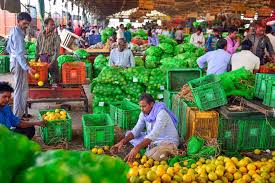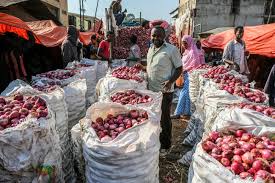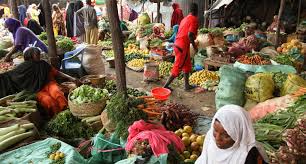Agricultural market potential refers to the vast opportunities and growth prospects within the agricultural sector, which is crucial for meeting the food demands of a rapidly growing global population.
With the world population expected to reach nearly 10 billion by 2050, the need for food and agricultural products is set to surge dramatically. This burgeoning demand creates significant potential for expansion and innovation, making agriculture a focal point for policymakers, investors, and entrepreneurs alike.
The agricultural market encompasses various activities, including crop production, livestock farming, food processing, and distribution, each contributing to the overall growth and sustainability of the sector.
As consumer preferences evolve towards health-conscious and environmentally sustainable choices, there is an increasing shift towards organic farming and local sourcing. This trend not only presents new opportunities for farmers but also stimulates innovation in agricultural technologies and practices.
Emerging technologies like precision agriculture, hydroponics, and vertical farming are reshaping traditional farming methods, enhancing efficiency, and maximizing yields. These advancements enable producers to meet rising consumer expectations while promoting sustainable practices.
Furthermore, the rise of e-commerce and digital platforms has revolutionized how agricultural products are marketed and sold. Farmers can connect directly with consumers, bypassing traditional supply chains, which can lead to better pricing and improved profit margins.
This direct-to-consumer model gained momentum during the COVID-19 pandemic as more individuals sought to purchase fresh produce and local goods online. Such access to broader markets benefits producers and allows consumers to enjoy fresher, high-quality products.
Government policies and initiatives aimed at supporting agriculture are vital for unlocking market potential. Many nations are implementing measures to enhance food security, support rural development, and encourage investment in the agricultural sector.
Policies such as subsidies, grants, and technical assistance programs aim to modernize agricultural practices and infrastructure.
By fostering a favorable business environment, governments can attract both domestic and foreign investment, further boosting the agricultural market.
However, climate change poses both challenges and opportunities for the agricultural sector. While extreme weather events and shifting climate patterns can negatively impact crop yields, there is also an increasing focus on climate-smart agriculture.
This approach emphasizes sustainable practices that enhance resilience and reduce greenhouse gas emissions. By investing in research and development, farmers can adopt resilient crops and innovative practices to ensure long-term productivity and sustainability.
Moreover, the global agricultural market is witnessing rising demand for non-food agricultural products, such as biofuels, fibers, and pharmaceuticals.
This diversification broadens the agricultural sector’s scope and contributes to sustainability efforts by reducing dependence on fossil fuels and promoting renewable resources.
As consumers and industries increasingly seek sustainable alternatives, the agricultural market is poised to play a crucial role in fulfilling these needs.
The agricultural market potential is vast, driven by demographic trends, technological advancements, changing consumer preferences, and supportive government policies.
As the world grapples with the challenges of sustainably feeding a growing population, agriculture stands at the forefront of innovation and opportunity.
Key Factors Influencing Agricultural Market Potential

Several factors play a vital role in determining agricultural market potential. Here are the most significant:
1. Economic Conditions: The overall health of the economy affects consumer spending and investment in agriculture. Economic growth leads to increased demand for food and agricultural products.
2. Supply Chain Efficiency: An efficient supply chain reduces costs and increases the availability of products. Farmers must ensure that their products reach consumers quickly and safely.
3. Government Policies: Agricultural policies, including subsidies, tariffs, and trade agreements, can significantly influence market potential. Supportive policies can enhance production and market access.
4. Technological Advancements: Innovations in technology, such as precision farming and biotechnology, improve yields and reduce costs. These advancements can help farmers meet growing market demands.
5. Consumer Preferences: Shifts in consumer preferences towards organic, locally sourced, and sustainable products influence market potential. Understanding these trends helps farmers align their production with market needs.
6. Climate Change: Climate variability can affect crop yields and production patterns. Farmers must adapt to changing conditions to maintain market competitiveness.
7. Globalization: The global interconnectedness of markets allows farmers to access international markets. However, it also increases competition from foreign producers.
Global Agricultural Market Trends
Monitoring global agricultural market trends is essential for understanding the potential of specific agricultural products. Here are some current trends:
1. Rise of Plant-Based Foods: Increasing awareness of health and environmental issues has led to a surge in demand for plant-based foods. This trend opens new markets for fruits, vegetables, legumes, and alternative protein sources.
2. Technological Integration: The adoption of digital tools and technologies in agriculture, such as mobile apps and data analytics, is on the rise. These tools help farmers optimize production and make informed decisions.
3. Sustainability Focus: Consumers are increasingly prioritizing sustainability in their purchasing decisions. Agricultural practices that promote sustainability can enhance market potential.
4. Local Sourcing: There is a growing preference for locally sourced products. Farmers who can market their products as fresh and local may find increased demand.
5. Global Supply Chain Challenges: Recent global events, including the COVID-19 pandemic, have disrupted supply chains. Farmers need to adapt to these challenges and find alternative marketing strategies.
Assessing Market Demand for Agricultural Products
Understanding market demand is critical for successful agricultural production. Here are steps to assess market demand effectively:
1. Market Research: Conduct thorough market research to gather information about consumer preferences, competitor offerings, and pricing trends. This data helps farmers make informed decisions about what to produce.
2. Analyze Historical Data: Study historical sales data to identify patterns and trends. Understanding past performance can help predict future demand for specific products.
3. Consumer Surveys: Conduct surveys to gather insights from consumers about their preferences and buying habits. This feedback can guide production decisions.
4. Monitor Social Media Trends: Social media platforms can provide valuable insights into consumer interests and trends. Monitoring conversations can help farmers identify emerging demands.
5. Collaborate with Industry Experts: Engaging with agricultural economists and market analysts can provide additional insights into market dynamics and demand forecasting.
Read Also: 18 Medicinal Health Benefits Of Alchornea glandulosa (Christmas bush)
Identifying Target Markets in Agriculture

Identifying target markets allows farmers to focus their efforts on specific consumer groups. Here are steps to identify potential target markets:
1. Segmentation: Divide the market into segments based on factors such as demographics, geographic location, and buying behavior. This segmentation helps farmers understand different consumer needs.
2. Analyze Market Size: Evaluate the size of each market segment to identify the most promising opportunities. Larger markets may offer greater sales potential.
3. Assess Competition: Analyze the level of competition in each segment. Less competitive markets may provide better opportunities for new entrants.
4. Understand Regulatory Requirements: Different markets may have specific regulations and standards. Understanding these requirements is essential for successful market entry.
5. Tailor Marketing Strategies: Once target markets are identified, tailor marketing strategies to meet their specific needs. This customization increases the chances of success.
Market Segmentation in Agriculture
Market segmentation involves dividing a broad market into smaller, more defined groups of consumers with similar needs or characteristics. This approach enables more focused marketing efforts. Here are the primary types of market segmentation in agriculture:
1. Geographic Segmentation: This divides the market based on location. Farmers can target consumers in specific regions, countries, or even local communities, allowing them to cater to local tastes and preferences.
2. Demographic Segmentation: This focuses on consumer characteristics such as age, gender, income level, and family size. Understanding demographic factors helps farmers tailor their products to meet specific consumer needs.
3. Psychographic Segmentation: This type considers consumers’ lifestyles, values, and attitudes. For instance, health-conscious consumers may prefer organic products, while environmentally aware consumers may seek sustainable farming practices.
4. Behavioral Segmentation: This segmentation is based on consumer behavior, including purchasing habits, brand loyalty, and usage rates. Understanding how consumers interact with products can guide marketing strategies effectively.
Innovations Driving Agricultural Market Potential
Innovations are transforming agriculture, enhancing productivity and market potential. Here are some key innovations driving this change:
1. Precision Agriculture: This technology utilizes GPS and data analytics to optimize field-level management regarding crop farming. By analyzing soil conditions, weather patterns, and crop health, farmers can make informed decisions that boost yields.
2. Biotechnology: Genetic engineering and biotechnological advancements are helping develop crops that are disease-resistant and have higher yields. These innovations are essential for meeting the growing global food demand.
3. Digital Agriculture: The use of mobile apps and digital platforms allows farmers to access real-time data, market information, and expert advice. This connectivity improves decision-making and market access.
4. Drones and Remote Sensing: Drones are used for crop monitoring, irrigation management, and precision application of fertilizers and pesticides. This technology reduces waste and enhances efficiency.
5. Vertical Farming: This innovative farming practice involves growing crops in vertically stacked layers, often in controlled environments. Vertical farming reduces land use and allows for year-round production, catering to urban markets.
Read Also: 20 Medicinal Health Benefits Of Bambusa vulgaris (Bamboo)
The Role of Technology in Agriculture Market Development

Technology plays a crucial role in the development of agricultural markets. Here are some ways technology contributes:
1. Improved Production Techniques: Modern technologies enhance production techniques, leading to higher yields and reduced costs. This efficiency increases competitiveness in the market.
2. Enhanced Supply Chain Management: Technology streamlines supply chain processes, ensuring timely delivery of products. Efficient logistics improve market access for farmers.
3. Data-Driven Decision Making: Access to data analytics allows farmers to make informed decisions based on market trends and consumer preferences. This knowledge leads to better-targeted marketing strategies.
4. E-commerce Platforms: Online marketplaces enable farmers to sell their products directly to consumers, reducing reliance on intermediaries. This approach can increase profit margins and market reach.
5. Consumer Engagement: Social media and digital marketing tools allow farmers to engage directly with consumers. Building relationships with customers can enhance brand loyalty and market share.
Sustainable Practices and Their Impact on Market Potential
Sustainable agricultural practices are becoming increasingly important in meeting market demands. Here are some key sustainable practices and their impacts:
1. Organic Farming: The demand for organic produce continues to rise as consumers seek healthier options. Adopting organic farming practices can open new market opportunities for farmers.
2. Crop Rotation: This practice helps maintain soil health and reduce pest and disease pressures. By promoting sustainable farming practices, farmers can attract environmentally conscious consumers.
3. Integrated Pest Management (IPM): IPM combines biological, cultural, and chemical practices to manage pests sustainably. This approach can enhance crop health and marketability.
4. Water Conservation: Sustainable water management practices, such as drip irrigation and rainwater harvesting, ensure efficient water use. These practices can attract markets focused on sustainability.
5. Certification Programs: Obtaining certifications for sustainable practices, such as Fair Trade or Rainforest Alliance, can enhance market potential by appealing to ethically minded consumers.
Challenges in Realizing Agricultural Market Potential
Despite the opportunities, several challenges can hinder the realization of agricultural market potential:
1. Market Access Barriers: Farmers may face difficulties accessing markets due to infrastructure issues, such as poor transportation networks and inadequate storage facilities.
2. Price Fluctuations: Agricultural markets are often subject to price volatility, making it challenging for farmers to predict income and manage expenses.
3. Climate Change: Changing weather patterns and extreme weather events can adversely affect crop yields and production, impacting market potential.
4. Lack of Knowledge and Training: Some farmers may lack access to training and resources to adopt modern agricultural practices and technologies effectively.
5. Regulatory Hurdles: Compliance with various regulations and standards can be challenging for farmers, especially smallholders, limiting their market opportunities.
Do you have any questions, suggestions, or contributions? If so, please feel free to use the comment box below to share your thoughts. We also encourage you to kindly share this information with others who might benefit from it. Since we can’t reach everyone at once, we truly appreciate your help in spreading the word. Thank you so much for your support and for sharing!
Read Also: How to Start an Urban Farm






